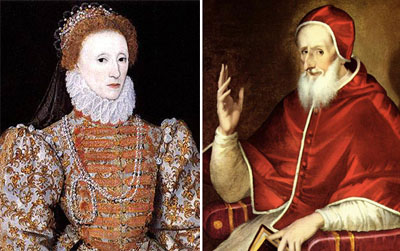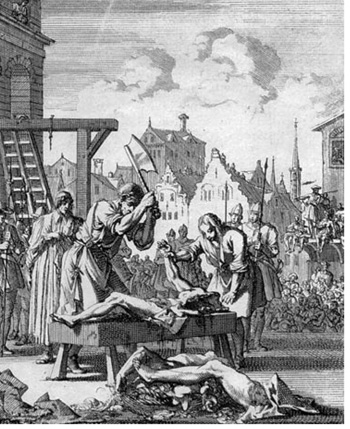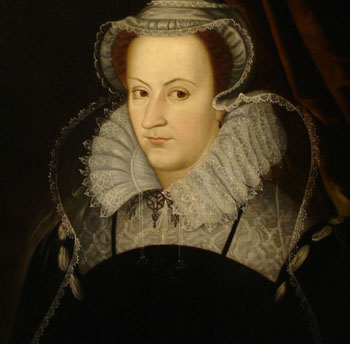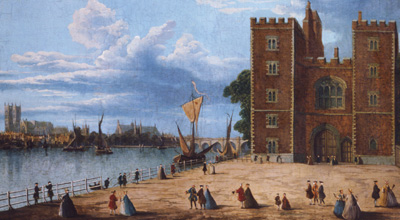 |
The Saint of the Day
Blessed John Felton – August 8
Prof. Plinio Corrêa de Oliveira
Biographical selection:
In 1570, St. Pius V wrote the Bull that excommunicated Elizabeth I of England. The Pope accused her of assuming illicitly the title of head of the Church, of deposing and imprisoning the canonically chosen Bishops and replaced them with schismatic bishops, of rejecting the ancient cult and favoring the new by receiving the sacraments in a heretical manner, of choosing heretics to form her council, and of imposing an oath harmful to the rights of the Holy See. He declared her guilty of heresy and stripped her of all her rights to the English Crown and released her subjects from obedience to her.

In 1570 Pius V issued a Bull excommunicating Elizabeth I |
After the document was written, it raised so many objections in the Papal Curia that St. Pius V hesitated for a moment before signing it.
In the meantime, a Catholic insurrection rose in northern England but failed, and Elizabeth ordered the execution of at least 800 individuals involved in it. The Pope ordered the publication of the Bull, and on the morning of May 24, 1570, it appeared posted on the doors of the Palace of the Bishop of London.
The Royal Council, extremely angry, immediately ordered a full investigation to discover the author of the “crime.” A lawyer accused John Felton. Felton was an aristocrat of great fortune and culture, gifted with a most vivacious personality and filled with enthusiasm for the Faith of his ancestors. After he was arrested, he proudly confessed that he had affixed the Bull on the doors of the episcopal palace. Even under torture, he refused to give the name of his auxiliaries and faced the death of the traitor; to the end he was proud of his action and declared himself a martyr of papal supremacy.
On the scaffold, he publicly denied the rights of Elizabeth to the throne; however, to show that he had no personal hatred for her, he asked the Count of Sussex to give her a valuable diamond ring that he removed from his finger before his death.
On August 8, 1570, Felton was hung; he was still alive when his virile organs were cut off to be thrown in the fire; his chest was opened to remove his heart; after being beheaded, his body was quartered. (Excerpt from Les Saints Militaires, Paris 1890, by Abbé Profillet)
Comments of Prof. Plinio:
This is a description of a terrible episode, replete with admirable significance.
As you know, during the Middle Ages and the beginning of the Modern Age, England was a Catholic nation. But, due to successive moral decadences since the time of St. Thomas Becket, still in the Middle Ages, England fell into an extraordinary religious lukewarmness.

The fate of denying the Elizabeth's claim to be head of the Church was hanging and quartering |
In the 16th century, King Henry VIII apostatized because he wanted the Pope to annul the marriage with his legitimate wife so that he could wed Anne Boleyn. The Pope refused. For this reason the King apostatized and almost all of England became heretical with him.
It is amazing to note that almost all of the English Bishops, almost all of the religious men and women, almost all of the clergy and almost all of the people were practicing the Catholic Religion with indifference, with disinterest. When the King apostatized, they accepted the new faith, which they could not but know was false.
They could not but know this because the Holy Spirit never abandons anyone and always gives the proportional strength to resist every danger. Grace is always available to help man and give him the strength to resist the temptation. Someone who leaves the Catholic Faith, therefore, commits a sin against the Holy Spirit, which is a most grave mortal sin. It is not possible for anyone to leave the Catholic Faith with good faith and authentic sincerity. Anyone who leaves it knows that he is leaving the truth and embracing error, and he knowingly takes this wicked action. Almost all of the English Nation committed this sin.
After the first phase, when this sin was committed, during which some great martyrs took good positions – such as Cardinal John Fisher and St. Thomas More – some reactions favoring the Catholic Faith surged. Its adherents were against Protestantism and plotted in secret to overthrow the Protestant Queen of England, Elizabeth I, the illegitimate daughter of the apostate Henry VIII and Anne Boleyn.

Queen Mary of Tudor, rightful heir to the throne, defended the Catholic Faith |
Before Elizabeth usurped the throne, the Queen had been Mary Tudor, a Catholic who was the legitimate daughter of Henry VIII and Queen Catherine of Aragon. Queen Mary had reestablished the Catholic Faith in England after the apostasy of her father and a short reign of her half-brother Edward. The English people, with a cynicism befitting of those times of Renaissance, after having become Protestant, returned to Catholicism. Then, once again, after the Catholic Queen Mary died, almost all of them reverted to Protestantism. This inconstancy reveals that they just wanted to live a good life and did not care about any religion.
Under the rule of Elizabeth I, however, a certain number of Catholics grouped together for their cause. They had the hope that Philip II, King of Spain – the Catholic King per excellence – would invade England to overthrow Elizabeth and reestablish the Catholic Faith in their country.
As you know, this did not happen, because although King Philip II prepared the Invincíble Armada, the winds dispersed it. The curious thing is that secular historians generally record the dispersion of the Undefeatable Fleet as a defeat for Philip II. I believe that this is a remarkable lack of vision. With a great spirit of faith, Philip II armed that fleet, which was so powerful that – if not for the winds – would have landed and conquered England. The Armada was not defeated; it was dispersed by a terrible storm. And so I ask: Who lost? Spain lost a fleet; England lost the Catholic Faith. Which nation was chastised? Obviously, it was England. It makes no sense to imagine that Spain was defeated.

The Armada sent by King Philip II was dispersed, but the defeated was England, who lost the Faith |
At that time, the Pope was St. Pius V. He decided to support the action of Philip II by issuing a Bull excommunicating Queen Elizabeth. The Bull was extremely severe. It declared Queen Elizabeth a heretic and as such it annulled her pretended rights to the Throne of England – pretended rights because she was an illegitimate child: the liaison of Henry VIII with her mother Anne Boleyn was not a marriage. Thus, she did not have right to the Throne.
So, the reasons for her deposition were: first, as an illegitimate child she could not be queen; second, even if she had the right to the throne, she would have lost it because she was a heretic.
It happened that part of the English people did not know that Queen Elizabeth was excommunicated. Thus, knowledge of the Bull would enlighten those persons and encourage their revolt and support for the effort of Philip II.
John Felton – a noble and wealthy man – had everything he needed to enjoy a pleasant life. However, after he received the Bull, setting aside all worldly interests, he resolved to make the public aware of its existence. He took the Bull and went to the most provocative place he could find, which was the doors of the palace of the bishop of London, the heretic bishop of London. He went there and posted the Bull on those doors.
We can imagine London – a great city for the time, but small compared to the megalopolis of our days – covered with the darkness of night. The noble Felton, with a mantle covering his body and a large hat covering his face to prevent recognition, walks silently along its streets with the Bull hidden under his cape. He avoids any encounter with the night police that could frustrate his endeavor. He goes and climbs the stone steps of the Palace, posts the Bull at the doors, and leaves quickly.

Lambeth Palace, the residence of the bishop of London at that time |
In the morning, before the important classes were up and moving about, the little people pass by the Palace, see the paper and approach to read the Bull. The word-of-mouth is out and spreads quickly, as it does in small cities. Soon, all the women of the market, the boatmen of the Thames, and the lackeys of the important houses were spreading the news everywhere: the Pope has excommunicated the Queen. He has declared that she does not have the right to govern and that the people should not obey her.
Denounced by a traitor, Felton was imprisoned. According to the false and heretical perspective of the Queen, he was guilty of treason because he was a noble plotting against his sovereign for her deposition. He was judged and condemned on the charge of high treason. Before his execution, he was also tortured to force him to reveal the names of collaborators.
The tortures of the time were terrible. But the men of that epoch had much more physical and moral resistance to torture than today’s man. Fenton heroically resisted the tortures without revealing a single name.
On the scaffold he made an action of supreme elegance: He clearly declared that Elizabeth had no right to the throne, but then he sent her a jewel to show that there was no personal hatred in his opposition. He took his stance moved by doctrinal, not personal reasons. It was a way to say: I did the right thing when I made this attempt against her power.
In the face of such great shame and so much horror, he became a splendorous example of fidelity to the Catholic cause.
We should recommend ourselves to Blessed Felton, asking him – if and when our turn to suffer torture and martyrdom comes – to give us his courage and perseverance so that, like him, our souls may become new stars shining in the firmament of the Church.


  |
|
Prof. Plinio Corrêa de Oliveira | |
The Saint of the Day features highlights from the lives of saints based on comments made by the late Prof. Plinio Corrêa de Oliveira. Following the example of St. John Bosco who used to make similar talks for the boys of his College, each evening it was Prof. Plinio’s custom to make a short commentary on the lives of the next day’s saint in a meeting for youth in order to encourage them in the practice of virtue and love for the Catholic Church. TIA thought that its readers could profit from these valuable commentaries.
The texts of both the biographical data and the comments come from personal notes taken by Atila S. Guimarães from 1964 to 1995. Given the fact that the source is a personal notebook, it is possible that at times the biographic notes transcribed here will not rigorously follow the original text read by Prof. Plinio. The commentaries have also been adapted and translated for TIA’s site.
|
Saint of the Day | Home | Books | CDs | Search | Contact Us | Donate

© 2002- Tradition in Action, Inc. All Rights Reserved
|
 |

|